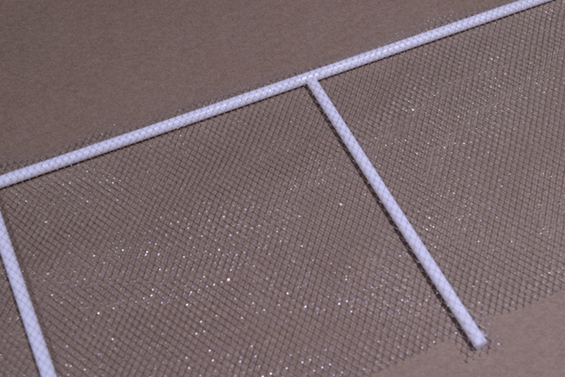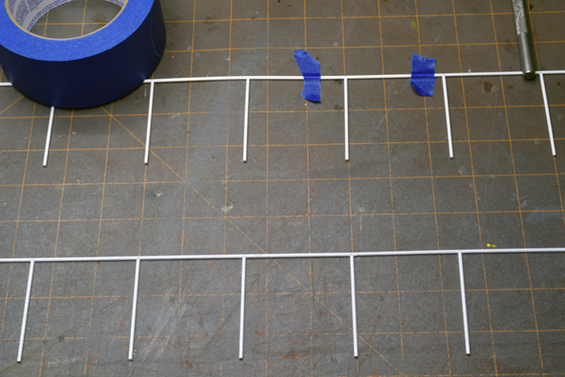Weeds have sprouted along the edges of the new access road I discussed in the last post. In addition, new sections of old chain link fence are being assembled, ready for fitting in place.
The fence is a simple affair made from 0.080″ styrene rod for the posts and top rail, along with pieces of wedding veil fabric purchased years ago at Walmart. An entire fabric yard of the stuff cost me less than 3-5 dollars, and is more than a lifetime supply of fencing.
I’d give dimensions for the fence but truthfully, it’s eyeballed for looks rather than measured. The fence posts are at ten foot intervals, which I have learned is the maximum spacing on the full-size versions. Depending on the height and the type of terrain traversed, post spacing varies up to the ten foot limit.
I simply make the framework for a section on the workbench, using pieces of tape to hold things in place during glue-up. Two feet seems the practical maximum length to handle without breaking it. There’s nothing fancy here, just butt joints and styrene cement. I remove the tape and lay a strip of the fabric down and brush more cement along each post and rail to secure it. I’ll leave this to dry overnight before trimming excess material away. The framework is often glued to the cutting mat at the joints but it’s easily loosened by sliding a single edged razor blade underneath. Once the fabric is trimmed up I give everything a coat of Tamiya Primer (always done outside) and weather appropriately. I want the fence to disappear into the background, so there are no details to speak of that would draw the eye to it.
I’ve left the posts long so that I can plant them in the scenery. These sections of fence are in the background and unlikely to be bumped or touched by stray hands, so I’m not overly concerned about how well they’re secured. As mentioned last week, the fence will weave in and out from shrubs, low trees and other scenic items. These will help disguise the ends of each section and negate the need to have a continuous run of fencing across the entire scene.
With nearly sixteen actual feet of fencing to do, I have my work cut out for me.
Feedback
I greatly appreciated Chris’s and the other comments last week and, there’s never any need to apologize for asking a question. Such questions provide opportunities to clarify my thoughts and advance the conversation. So, thanks to all of you who do comment, however infrequently.
In my deliberations prior to making the changes, I was prepared to do just as Chris suggested by removing the yard track and turnout to the run-around, then extend the passing siding along the main to use for the setouts. Since all my switching is a trailing point move now, I have no problem loosing the run-around.
Such ideas often sound good in the abstract but not so good in reality. Before plunging in I did one final experiment with a few freight cars and determined that cars on the rear track would be very hard to see and work (couple/uncouple), if other cars were sitting in front of them on the main. I encountered this situation before and didn’t see the sense in recreating a problem I’ve already solved. Therefore I decided to leave the track arrangement as it is.
Further, that weedy sliver of open space between the main and the yard adds a note of breathing room that I feel is important. In this scale it’s so easy to crowd things, something many of you intuitively understand judging by your comments. As I work on the scene I’m happy with how it’s coming together.
Regards, Mike


Good morning Mike
The fence project sounds neat. When I saw it at the top of this post I caught myself thinking: “See what progress he unlocked with the track edit”. Not only did the existing scene become more balanced to your vision with that work but a project like this happened too. It really speaks to your relationship with your vision for the layout and your courage to execute it.
In the second half of the post you mentioned that one of the drivers for the decision to remove the track was the challenge of working it. I went back and looked at some other photos of your layout and can now appreciate that it wouldn’t have been easy. I’ve never been a fan of uncoupling cars from over another set. Maybe it’s silly but I started to think that I liked to uncouple cars the way I would in real life and from a position of working alongside the string – that I wouldn’t crawl over a set to get to the ones in behind to uncouple those if I could have just walked on the opposite side all along. Since those sidings are only worked from the front of the layout the operator sort of would be crawling over the ones in front to work the ones in back even if only visually.
/chris
Hi Chris,
Thanks. The fence was an option I considered for a long time. There’s one at Valley Jct. that separates the yard from another property behind it, so adding it to the layout is accurate. As you guessed the crowded nature of the scene kept giving me doubts.
As for working a string of cars, it occurred to me that I could have positioned the conductor/brakeman near the old station platform and had the engine pull the string out until he’s ready to make a cut.
This would have eliminated the reach-over and visibility issues from the two closely spaced tracks, however, the logical place to position myself as brakeman has a stand of trees in the way, so reach-in cropped up as a problem again. I could have removed the trees but they serve an important function visually.
These reasons suggested that the existing arrangement was sufficient, not perfect but sufficient. Therefore, I decided to leave the tracks as they are.
Regards,
Mike
The boundary fence will serve as a visual cue to the observer, saying, “Here endeth the railway.” By having some shrubs, bushes, what have you beyond it, the observer will sub-consciously see that there is a world outside the modelled scene, rather than the layout coming to an abrupt end. Just like having too much track, it is possible to spoil the effect by haing too much railway land, and not enough of the outisde world.
In the UK, railways are required to be fenced in – just being on railway property is an act of trespass without the need to break something, so you need to know where the boundary is. Because of this, a fence or hedge is commonly used right at the layout’s edge, rather than setting it in from the edge to create the suggestion of “more”, outside of the baseboard.
These subtle effects all go together to build the picture.
Nice one.
Simon
Hi Mike,
Having been a yard conductor/switchman, I like your idea of pulling the cut of cars on any track out toward you or over the switch to make a cut. One thing you try to learn first as a switchman is to eliminate as much walking as possible. To make a cut on any of your tracks you’ll need an accurate track list to show how your cars are positioned. If one is lacking you’ll be way ahead of the game by coupling up the switch engine to the cars and pulling them past you to make your list rather than walking the track. This will save both shoe leather and time. Also, make sure you position yourself so you can pass signals to the engineer. Once the list is made you’ll be able to determine where to make your cuts. If you have a helper tending the switch you can pretty much stand at one spot relative to the two or three tracks you’re working with your list in hand. You’ll probably still have to take a short walk across to whatever track you’re making the cut on just so the engineer can see you and your signals from whatever side of the track is best. You also want a good view of the cars being shoved toward you. When doing this you’ll find that the ends of cuts of cars on each track will be adjacent to each other. This way you won’t have to climb between and over any cars to get over to the other tracks. Believe me, you don’t want to do this when you get really tired.
I’m not writing this to influence how much or how little track you have. What bothers me is that I see too many model railroaders try to look down on a yard track to find a particular car. This isn’t possible or done on the real thing. Let’s couple up the switcher to that track full of cars hiding behind the one blocking our view and pull them out to take a look.
Beyond that, I really like what you’ve done to the layout to more closely capture the feel of the prototype yard you’re following. The scene actually looks a lot larger to me.
You’ve influenced me to do something similar on my own layout and I’m delighted with the results so far. Even though I model in HO, I was trying to cram in more things than actually existed in the prototype scene I’m following. I did this because I thought they were “neat” and would add to my traffic base. As a result, viewing this scene was always a disappointment to me. As I rip out the made up or fictional elements I know I’m on the road to happiness!
Thanks,
Ken Thompson
Hi Ken,
Thanks for sharing your experience and insight on real world switching practice. It adds so much to the conversation I try to have on the site. What you described is how I thought I could switch the yard if I were to follow Chris’s earlier suggestion and also, it reflects what I’ve seen local crews do as they work the industry in town. We’ve really burdened ourselves with so many made up conventions and routines that have nothing to do with prototype operations, when doing things as the prototype does is often so much simpler and more enjoyable.
Great, great comment. Thank you so much for sharing it.
Regards,
Mike